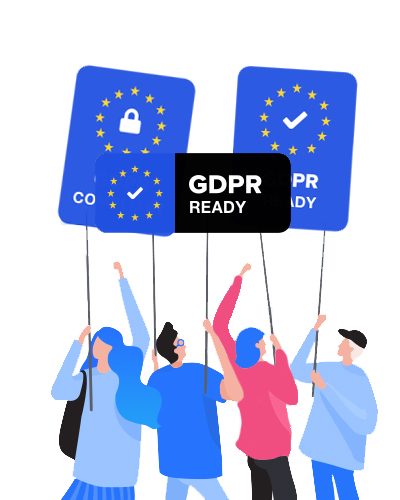On 25th May 2018, the GDPR (General Data Protection Regulation) enacted by the EU will come into effect. But is your website really GDPR compliant? Do you really need to take care of these new guidelines? What if you neglect this?
This article will help you to get ready when the regulation kicks in and have a better understanding of the changes to come.
- We’re going to talk about the specific areas of your business that the guidelines affect, and why you should be concerned about GDPR compliance.
- We will cover the basics of making a Website compliant.
EU data protection regulation simply explained
What is GDPR?
Disclaimer. This article is not legal advice. We’re not lawyers.
GDPR stands for General Data Protection Regulation and it is a new data protection law in the EU, which comes into force in May 2018.
 The aim of the GDPR is to give citizens of the EU control over their personal data and change the approach of organizations across the world towards data privacy. The GDPR provides much stronger rules than existing laws and is much more restrictive than the “EU cookie law.”
The aim of the GDPR is to give citizens of the EU control over their personal data and change the approach of organizations across the world towards data privacy. The GDPR provides much stronger rules than existing laws and is much more restrictive than the “EU cookie law.”
For instance, users must confirm that their data can be collected, there must a clear privacy policy showing what data is going to be stored, how it is going to be used, and provide the user a right to withdraw the consent to the use of personal data (consequently deleting the data), if required.
The GDPR applies to data collected about EU citizens from anywhere in the world. As a consequence, a website with any EU visitors or customers must comply with the GDPR, which means virtually all businesses that want to sell products or services to the European market.
To better understand the regulation, take a look at the publication of the regulations in the Official Journal of the European Union, which defines all terms related to the law. There are two main aspects of the GDPR: “personal data” and “processing of personal data.”
Time until GDPR
There are only a few days left to comply with the new guidelines.
Should GDPR be taken seriously?
Businesses have time until May 2018 to comply with the regulations set by the GDPR. The penalty for non compliance can be up to € 20 million, or in the case of an undertaking, up to 4% of the total worldwide annual turnover of the preceding financial year, whichever is higher.
There are various slabs of penalties according to the seriousness of the breach, which have been described in the FAQ section of the GDPR portal.
Such a high amount in penalties has been proposed to increase compliance. However, one may wonder what steps for the supervision of websites are in place. Supervisory Authorities (SA) of different member states are going to be set up, with the full support of the law.
Six months after the guidelines were released, PwC surveyed 200 CXOs of large US firms to assess the impact of the GDPR guidelines. The results revealed that a majority of the firms had taken up the GDPR guidelines as their top data protection priority, with 76% of them prepared to spend in excess of $1 million on GDPR. This shows that owing to a substantial presence in the EU, large corporations are taking up the GDPR compliance seriously.
What companies are willing to spend on GDPR compliance
All numbers are in %
(Charts by Visualizer Lite.)
The details of your WordPress GDPR compliance
Okay, so with all that said, let´s make sure that your website is compliant and that you won’t experience any GDPR problems.
Before you move on to each of the aspects and how to comply with them, contact us and request your free security audit for your WordPress site to reveal how data is being processed and stored on your servers, and steps that are required to comply with the GDPR.
After inspecting your websites data-storage, our team wil then proceed to make your website GDPR compliant. This includes :
- The user right to request to eraze his data
- The user right to request a downloadable version of all his data
- The user right to request his data in a portabel format (when customer changes providers for exmple)
- The user right to enable or disable specific cookies for specific functions
Besides of the extended user rights, the website needs to comply with the following technical points :
- Cookie Consents – User accepts or accepts not cookies
- Right to be forgotten – User can request data delete
- Data Access – User can access his data
- Pseudonymisation – User data is pseudonymised to secure personal identity
- Data Breach Notification – A email to all users to notify within 72 hours about past data breach
Final thoughts
To sum up what it means to make WordPress GDPR compliant:
- the law comes into effect in May 2018,
- it applies to any website that deals with personal information of EU users,
- it gives the user the right to control the flow of their personal information,
- there are defined processes to monitor compliance and huge fines are in place for non-compliance.
If you don’t have all of the above taken care of by May 2018, trouble. Nonetheless, the GDPR regulation is the right step in ensuring transparency in handling of data. Although this post has covered the basics of GDPR, you may want to go through the regulation in detail if you have a profitable business running behind your WordPress website. Remember, not complying can result in administrative fines up to € 20 million, or in the case of an undertaking, up to 4% of the total worldwide annual turnover of the preceding financial year, whichever is higher.


 Deutsch
Deutsch Français
Français


